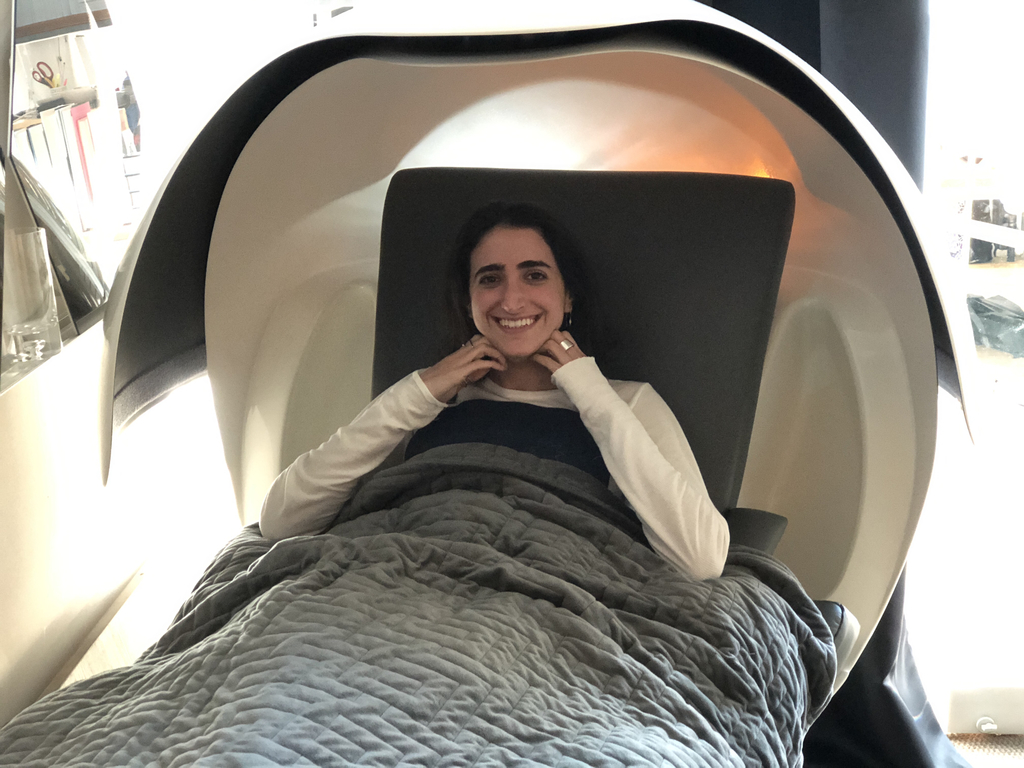It’s not every day that one tries to fall asleep in the middle of the work day, swaddled in the warm embrace of a 20 pound blanket that costs almost $300 (it was $279 but is now on sale for $250). That day came for me this week when I tried out the viral internet sensation that is the Gravity blanket.
It feels like what you might guess a soft mass of 20 pounds evenly spread across your body to feel like: the pressure is not uncomfortable, but it’s certainly there. I often kick and thrash in my sleep, but the blanket’s pressure made it difficult to move, but not in a bad way. The blanket was a velvety presence saying sternly, but lovingly, be still. Though I am not a good napper, enveloped by the unbelievably heavy blanket, I actually fell asleep.
The Gravity blanket made internet waves earlier this year when it raised a remarkable $4,729,263 during its Kickstarter campaign. It’s marketed as a “natural solution for a stressed-out society” which includes helping you get better sleep, according to its website.
The weighted blanket comes in 15, 20 and 25 pound options. You’re recommended to choose a blanket that’s about 10 percent of their bodyweight. The “hugging” sensation that I enjoyed so much can, according to its website, reportedly help people stay still and calm throughout the night.
I can’t speak to whether the blanket helped me sleep through the night better as I only took it for a cool 20-minute nap. (It was too heavy to lug home, and we were on an office-based trial period with the blanket. And despite the hilarity that would ensue trying to get a 20 pound blanket from Manhattan to Brooklyn on the subway, I have horrifying visions of the blanket getting pulled into a “Showtime” routine.)
What I can say is that I’ve never been able to nap in the middle of the day, despite trying. I’ve tried napping in the backseat of my car, on the subway, behind an artfully constructed stack of binders during class in college, in doctor’s waiting rooms. Most workplaces make it pretty difficult to nap—I am reminded of an episode of The Office where Kelly Kapoor is gifted with a nap sanctuary by her coworkers: a blanket on the floor underneath the conference room table. But to be clear, at Thrive Global we have a nap pod, so we are blessed with the resources to nap if one desires. But until now, my forays into the nap pod have been fruitless and resulted in ample selfies of me inside the strange futuristic orb.
Mike Grillo, Gravity’s managing director, brought the blanket to the Thrive Global offices and explained that it can be used to help a variety of conditions including stress, anxiety, insomnia and post-traumatic stress disorder. It’s not hard to imagine that something incredibly soft and heavy could help people feel comfortable.
Still, the science behind the blanket is rather thin, though weighted blankets have been used in occupational therapy for a while. The company changed their Kickstarter page to reflect that it can be used to help people with certain health conditions, not necessarily treat them, as STAT News reported. But the sheer number of people yearning to spend $279 on what some may consider a glorified comforter (it’s not) exemplifies how desperate people are to get better sleep.
Sleep, and how to improve it, is very much in the zeitgeist right now. It’s “trendy.” There’s a good reason for that: the CDC estimates that between 50 and 70 million Americans suffer from a sleep disorder or sleep-deprivation, which they label a public health problem. The National Sleep Foundation recommends that adults get between 7 to 9 hours of sleep a night. And unless you have a rare genetic mutation, functioning on less sleep than you need is basically like walking around drunk. Sleep-deprived people are also at greater risk for a host of chronic diseases, depression, obesity and cancer, not to mention increased mortality. And while upward of nine million Americans use a prescription sleep aid, the research indicates that sleeping pills actually lead to less of the deepest, most restorative forms of sleep.
Plus, just in time for Halloween, the popular sleeping pill Ambien has been linked to many spooky side effects like sleepwalking and midnight trips to the kitchen. “Night eaters said they woke up to find Tostitos and Snickers wrappers in their beds,” the New York Times reports in an article about the side effects of sleeping pills.” Ambien has also been connected to legitimately horrifying effects too, like sleep-driving.
And among the wide, weird realm of non-prescription sleep aids, the Gravity blanket seems very mild. Jerome Groopman wrote about how many sleep-related gadgets were at the Consumer Electronics Show in 2017 for The New Yorker, everything from a breathing sensor that you strap to your chest which, naturally, comes with an app that helps you coordinate breathing with “tonal music” to help lower anxiety to a six-foot pod called the Magnesphere which surrounds you with “allegedly restorative electromagnetic fields,” he wrote.
It’s easy to understand why a heavy blanket—that wouldn’t directly cause one to wind up with Snickers wrappers in their bed or involve electromagnetic fields—would be alluring.
So while I can’t confirm that the Gravity blanket scientifically improves your sleep, in my experience, I felt an undeniable feeling of safety after being tucked snugly under a plush 20-pound blanket. I imagine it’s not dissimilar to how dogs feel when they get strapped into a ThunderShirt before an incoming storm. The blanket might just help people cultivate their sleep-hygiene routine, which can (and should) include things like leaving your phone out of the bedroom and limiting screens before bedtime. And if you’re not convinced, just remember that the worst thing that happens is you have a soft and heavy blanket in which to hide from the world under.


